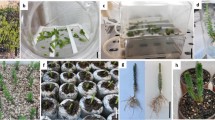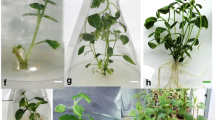Abstract
In vitro propagation of the rose rootstock ‘Moneyway’ was investigated on the following media: Murashige and Skoog (MS), Quoirin and Lepoivre (QL) and Woody Plant (WP). Growth, which was measured as length of shoots after a 6-week period, was faster on MS and QL than on WP. In spite of the better growth, chlorosis of newly formed leaves occurred from the third week on and was correlated with a lower chlorophyll content of shoots. Replacement of FeEDTA by FeEDDHA in QL and MS resulted in the development of green shoots for more than 3 months. The occurrence of chlorosis was not pH directed since the pH of QL with FeEDTA or FeEDDHA had not changed after 6 weeks of growth. Addition of the light absorbing dye fast yellow 9 to QL with FeEDTA also resulted in green shoots with a higher chlorophyll content. It is suggested that FeEDDHA is a more photostable chelate than FeEDTA, resulting in a higher availability of iron for the rose shoots. The impact of the iron chelate formula on the micropropagation of plant species that are susceptible to iron deficiency is discussed.
Similar content being viewed by others
Abbreviations
- BA:
-
6-benzyladenine, fast yellow 9-4-amino-1,1′-azobenzene-3,4′-disulfonic acid
- FeEDTA:
-
ferric ethylenediamine tetraacetate
- FeEDDHA:
-
ferric ethylenediamine di(o-hydroxyphenylacetate)
- IAA:
-
indole-3-acetic acid
- IBA:
-
indole-3-butyric acid
- LSD:
-
least significant difference
- NAA:
-
α-naphthaleneacetic acid
- P:
-
probability
References
Anderson WC (1984) A revised tissue culture medium for shoot multiplication of rhododendron. J. Amer. Soc. Hort. Sci. 109: 343–347
Bruinsma J (1963) The quantitative analysis of chlorophylls a and b in plant extracts. Photochem. Photobiol. 2: 241–249
Dolcet-Sanjuan R, Mok DWS & Mok MC (1990) Micropropagation of Pyrus and Cydonia and their responses to Fe-limiting conditions. Plant Cell Tiss. Org. Cult. 21: 191–199
Halvorson AD & Lindsay WL (1972) Equilibrium relationships of metal chelates in hydroponic solutions. Soil Sci. Soc. Amer. Proc. 36: 755–761
Horn WAH (1992) Micropropagation of rose (Rosa L.) In: Bajai YPS (Ed) Biotechnology in Agriculture and Forestry, Vol 20, Hightech and Micropropagation IV (pp 320–342). Springer-Verlag, Berlin, Heidelberg
Hyndman SE, Hasegawa PM & Bressan RA (1982) Stimulation of root initiation from cultured rose shoots through the use of reduced concentrations of mineral salts. HortScience 17: 82–83
Khosh-Khui & Sink KC (1982) Rooting-enhancement of Rosa hybrida for tissue culture propagation. Scientia Hortic. 17: 371–376
Lloyd G & McCown B (1981) Commercially-feasible micropropagation of mountain laurel, Kalmia latifolia, by use of shoot tip culture. Comb. Proc. Int. Plant Prop. Soc. 30: 421–427
Mengel K & Kirkby EA (1978) Principles of Plant Nutrition (pp 425–440). Der Bund AG, Bern
Murashige T & Skoog F (1962) A revised medium for rapid growth and bioassays with tobacco tissue cultures. Physiol. Plant. 15: 473–497
Quoirin M, Lepoivre Ph & Boxus Ph (1977) Un premier bilan de 10 années de recherches sur les cultures de méristèmes et la multiplication in vitro de fruitiers ligneux. In: C. R. Rech. 1976–1977 et Rapports de Synthèse Stat. des Cult. Fruit. et Maraîch., Gembloux: 93–117
Schenk RU & Hildebrandt AC (1972) Medium and techniques for induction and growth of monocotyledonous and dicotyledonous plant cell cultures. Can. J. Bot. 50: 199–204
Short KC & Roberts AV (1991) Rosa sp. (Roses): In vitro culture, micropropagation, and the production of secondary products. In: Bajaj YPS (Ed) Biotechnology in Agriculture and Forestry, Vol 15, Medicinal and Aromatic plants III (pp 376–397). Springer-Verlag, Berlin, Heidelberg
Skirvin RM & Chu MC (1979) In vitro propagation of ‘Forever Yours’ rose. HortScience 14: 608–610
Skirvin RM, Chu MC & Young HJ (1990) Rose. In: Ammirato PV, Evans DA, Sharp WR & Bajaj YPS (Eds) Handbook of Plant Cell Culture, Vol 5, Ornamental Species (pp 716–743). McGraw-Hill, New York
Valles M & Boxus Ph (1987) Micropropagation of several Rosa hybrida L. cultivars. Acta Hort. 212: 611–617
Wallace A, Mueller RT, Lunt OR, Ashcraft RT & Shannon LM (1955) Comparison of five chelating agents in soils, in nutrient solutions, and in plant responses. Soil Sci. 80: 101–108
Author information
Authors and Affiliations
Rights and permissions
About this article
Cite this article
Van der Salm, T.P.M., Van der Toorn, C.J.G., Hänisch ten Cate, C.H. et al. Importance of the iron chelate formula for micropropagation of Rosa hybrida L. ‘Moneyway’. Plant Cell Tiss Organ Cult 37, 73–77 (1994). https://doi.org/10.1007/BF00048120
Received:
Accepted:
Issue Date:
DOI: https://doi.org/10.1007/BF00048120




